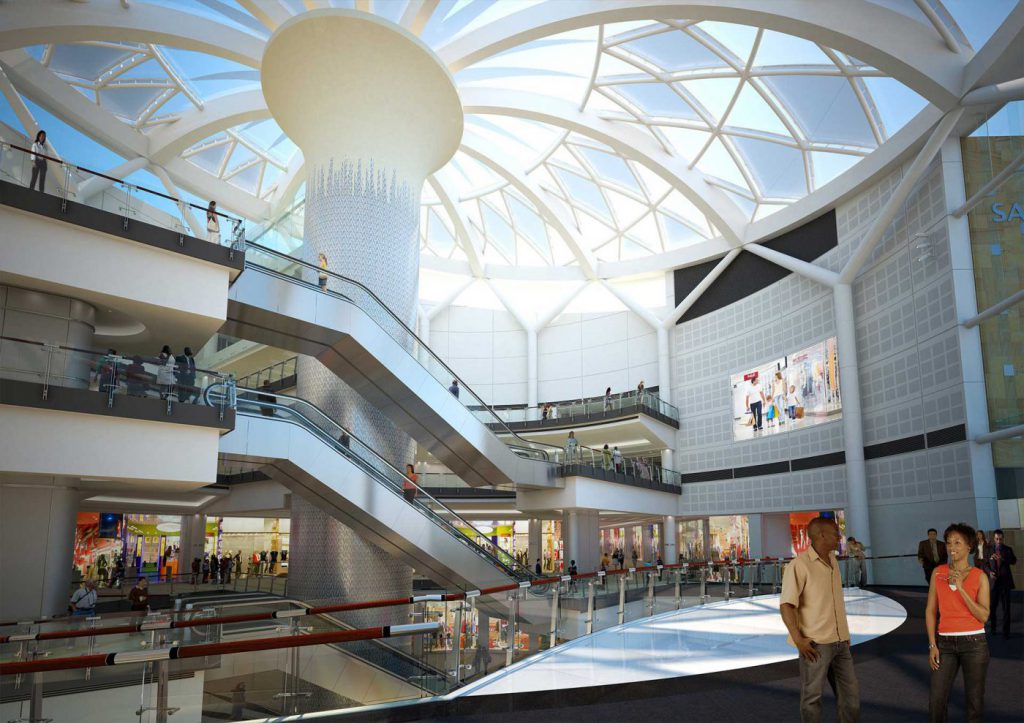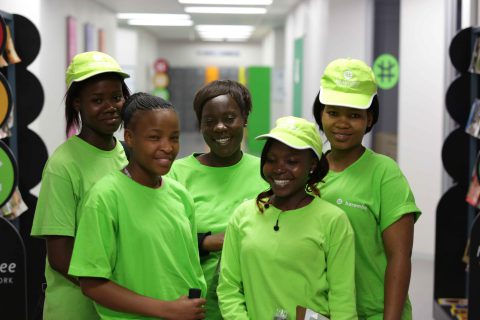Sunday Times Malls SA
Making Malls Better
“Consumers today are driven by a sense of exploration or a fear of missing out, and are always on the hunt for new experiences,” says Yvonne Court, Cushman & Wakefield partner and head of international consultancy, and co-head of a dedicated cross-border retail and leisure team. “Tastes and sensibilities are changing, fuelling much greater customisation, authenticity and innovation.”
Court was speaking at the South African Council of Shopping Centres (SACSC) annual research conference at the Maslow Hotel in Sandton. Highlighting some key trends in the evolution of shopping centres, Court said people were looking for memorable experiences from malls.
Food gains favour
One of the ways malls respond to customer demand is by enhancing their food offering. Court says curiosity is a big driver for consumers who want greater exposure to international foods and flavours.
“Today’s customers are much more educated and expect more of their experiences. They want a top-notch dining experience, whether they are going to a white-tablecloth restaurant or a fast food outlet. They still want quality, convenience, speed and a good price.”
She says food has become a culture. People want to share their latest dining experience on social media, and malls have to adapt to this. Malls now have more space dedicated to food and beverages than ever before – from 5% to 35% of gross lettable area (GLA) in malls globally.
These food and beverage outlets are now also spread throughout the mall – they’re not just found in a dedicated food court; and it is estimated that 60% of mall visitors eat or drink something while they’re there.
Conscience is key
With the evolution of social consciousness, people are not only seeking out malls for the experiences they offer, but for the knowledge that they are participating in a sustainable venture.
“Modern trends in development and construction are predominantly focused on issues relating to sustainability as residents and investors want to know what is being done to reduce the impact on the environment,” says Nicholas Stopforth, managing director of Amdec Property Development.
“The world over, developers are under pressure to drastically minimise water usage and incorporate eco-friendly technologies that will benefit the planet in the long term.”
Sustainability and eco-friendly innovation are key focus areas of Amdec’s developments. These include the mixed-use developments of Melrose Arch in Johannesburg and Harbour Arch in Cape Town. Their green building initiatives include refuse recycling, water-saving devices, low-energy LED lighting and rainwater harvesting.
With water scarcity a big problem, developers need to implement water-wise strategies from the beginning. Harbour Arch, for example, is designed to harvest rainwater to reduce the demand on municipal supply.
Melrose Arch offers sustainability features ranging from electric car-charging stations to centralised air conditioning, waste collection, recycling and rainwater harvesting. Melrose Arch is designed to be cost-efficient and environmentally friendly. The precinct has ample open spaces and buildings are designed to make the most of natural light, like the Galleria’s glass roof, for example. Buildings have courtyards for tenants’ use, with gardens and water features, allowing open areas for relaxation.
The precinct is self-sustaining and manages its own water harvesting, waste removal and recycling, with about 43% of its waste recycled and converted into gas.
It also has its own back-up power generators, with a 20 000-litre storage facility that can operate for eight to 12 hours, while water for construction can be drawn from the aquifer below the site.
Mixed use
“Mixed use” is the buzzword in South African development, describing the desire for people to have locations in which they can live, work and play. Instead of the traditional mall, mixed-use developments offer apartments, retail frontage, gyms, open spaces and entertainment areas.
This is particularly appealing for residents, but the integrated lifestyle vibe of these developments is a drawcard for out-of-area visitors too. They feel like they are visiting a suburb, rather than a shopping centre. “Being a mixed-use precinct, people visit Melrose Arch for different reasons,” says Melrose Arch managing director Mike Vermaak. “However, we’ve found that the one thing our visitors have in common is that they appreciate the convenience of the precinct. They can park, go to work, go to gym, run errands, go shopping and meet friends for dinner, without having to leave Melrose Arch.”
Fun for the little ones
South African malls are on a mission to become everything to everyone, and this means catering to the needs of their youngest customers too. Sandton City has created a Fun District, an area dedicated to unique entertainment-based offerings.
“Families are looking for more ways to spend time together and Sandton City is a great place to do that. Sandton City’s new family-fun level adds another exciting dimension to the ultimate shopping variety and experience on the continent,” says Jonathan Sinden, chief operations officer for Liberty Two Degrees, co-owners of Sandton City.
The new attraction features the biggest Hamleys in South Africa, measuring 1 903m2. Kids visiting Hamleys can ride a slide straight into the shop, and have fun on an in-store carousel.
Sandton City’s Fun District sports a new Spur restaurant, offering signature meals and a Halaal menu for the entire family to enjoy. This is situated next to Hamleys. The Fun District has a revitalised cinema level, which already offers Sandton City’s 11-screen Ster-Kinekor cinema including Cine Prestige, 3D and 2D experiences.
Durban’s Gateway Mall, which describes itself as the “theatre of shopping”, has incorporated go-karting, adventure putt-putt and WavePark into its centre. This kind of attraction brings families to the mall primarily for these facilities, with shopping as an add-on.
Last year Gateway began an expansion of 20 000m2 that will make the mall the third largest in Africa. “In line with Gateway’s vision to remain the greatest shopping and entertainment complex in the Southern Hemisphere, the centre has commenced with an exciting development and expansion project that aims to further enhance the retail, leisure, food and entertainment offering,” said Akash Maharaj, the portfolio manager for Gateway, at the commencement of the expansion in April last year.
Entertainment for the adults as well
Some mall visitors don’t come to shop, but come for the entertainment. This includes all ages – from babies, toddlers and kids, to teens who are too young to go to pubs and clubs, but who want to go out. However the best malls are those that offer entertainment that appeals to adults as well.
At the V&A Waterfront in Cape Town, the whole family can enjoy the Two Oceans Aquarium, and adults can enjoy the Cape Town Comedy Club, depart on a Cape Town City Cycle Tour, enjoy a sunset cruise or participate in any of the waterfront’s monthly public events.
The recent addition of the Zeitz MOCAA, the museum of contemporary African art, to the V&A Waterfront is also attracting a lot of new visitors.
Making mega malls
For some mall development companies, bigger is better. Their attraction isn’t local convenience, but rather their expansive offerings all under one roof.
The new regional Table Bay Mall opened in Sunningdale, Cape Town, in September last year. It has over 65 000m2 of retail space, which can be expanded to 90 000m2, and has anchor brand tenants that include Woolworths, H&M, Pick n Pay and Checkers. It offers 1 300 outside and 2 000 undercover parking bays, with access to the mall via three main lobbies.
The mall aims to provide customers with “everything under one roof”, with the central entrance bordered by coffee shops, restaurants and eateries, and a central exhibition space offering a home for events and entertainment.
When a mall hopes to draw crowds who stay to shop, eat and play, the aesthetic of the space is important. The mall’s website states that “our signature design inspired by the curved, flowing lines of the world’s most elegant super yachts makes for a memorable shopping experience and visual enjoyment. Its overarching design elements bring a sense of space, natural light and movement into the mall”.
Besides having been water-conscious during construction, further measures were implemented at Table Bay Mall to ensure that it remains sustainable in the future, says centre manager Janine Coleske. These include rainwater harvesting, dry and indigenous planting, LED lighting and daylight harvesting.
Fourways Mall in Johannesburg is another that’s aiming for regional domination. The addition of 90 000m2 brings it to 170 000m2, incorporating the existing mall, Game Centre and the smaller Fourways View Centre. The massive renovation is due for completion this year. The intention of the expansion is not only to attract more customers but also to support plans by the local council to position the Fourways area as a new CBD, as Fourways has been identified as one of Joburg’s fastest growing areas.
Specific destinations within the mall will be Hamleys, fashion retailer Forever 21, trampoline company Bounce, as well as many international brands launching onto the South African market.
Neighbourhood malls
At the South African Council of Shopping Centres conference, Lynne Krog, Caxton Community Papers’ business manager, presented the findings of research her company carried out across 120 communities to get a clear picture of consumer behaviour. One of the key findings was that the catchment areas for each mall are shrinking.
“People who would have travelled 45 minutes to an hour to get to a shopping centre are now only willing to travel for 15 to 20 minutes,” she said.
This means that while larger, established malls will attract customers with their food and entertainment offerings, and retail mix, people expect convenience on their doorstep, and will head to the nearest mall that meets their needs. This means that every neighbourhood mall should offer a cross-section of the features already mentioned, to keep their hyper-local convenience customers returning.
South Africans love their malls, and as these centres of shopping, food and so much more continue to evolve to satisfy customer desires and curiosity, people will keep coming back for more.






 Sign-up and receive the Business Media MAGS newsletter OR SA Mining newsletter straight to your inbox.
Sign-up and receive the Business Media MAGS newsletter OR SA Mining newsletter straight to your inbox.